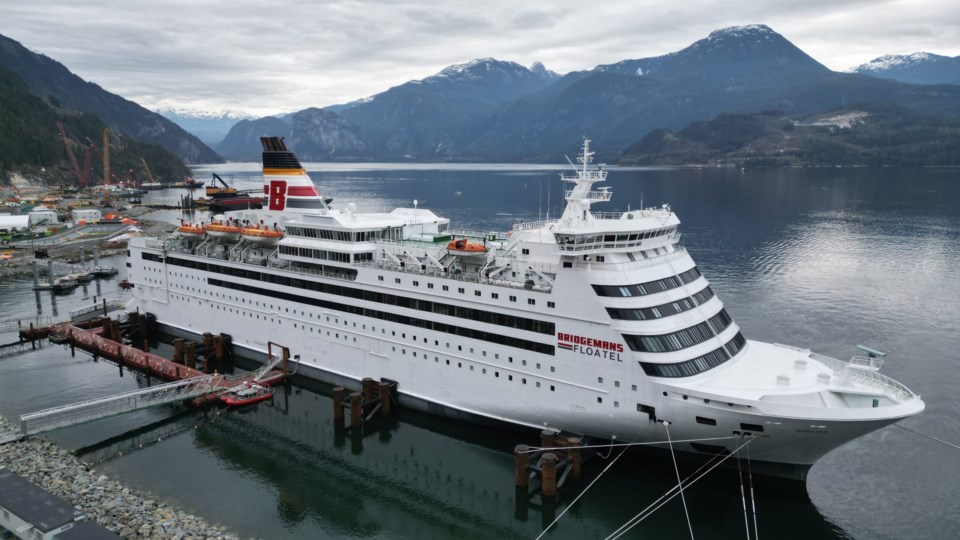A federal judge has turned down a legal challenge against Woodfibre LNG over an approval to repurpose a cruise ship housing workers brought in to build a major liquefied natural gas facility near Squamish, B.C.
The advocacy group Citizens for My Sea to Sky had sought a judicial review of a federal decision that granted the company the ability to amend its environmental authorizations to accommodate the parked ship, dubbed the “floatel.”
The Impact Assessment Agency of Canada had approved Woodfibre LNG's request under the federal Environmental Assessment Act. In court, My Sea to Sky argued that decision was unreasonable and failed to properly address the heightened risk of gender-based violence that arises when a large number of construction workers are housed near small or remote communities.
The group also claimed the decision breached procedural fairness by failing to hold a public comment period before making the decision, and failed to consider how the decision would impact human rights protected under the Canadian Charter of Rights and Freedoms.
In his decision released June 20, Justice Sébastien Grammond found the federal agency had acted reasonably and balanced Charter rights. The judge also rejected the notion that procedural fairness had been breached, ruling there was no legal duty to allow the public to weigh in on the matter.
“If procedural fairness did not require the Agency to provide My Sea to Sky with an opportunity to make submissions, My Sea to Sky cannot create such a duty simply by asking,” wrote the judge.
Woodfibre LNG is building the gas processing facility at the site of an abandoned pulp and paper mill on Howe Sound. Once finished, it will receive gas from extraction sites in northern B.C. A pipeline is currently under construction to bring the required gas the last 47 kilometres from Metro Vancouver. Construction is currently estimated to be completed by 2027.
In 2012, the Impact Assessment Agency produced an analysis report, including a four-page document looking at the socio-economic effects of constructing the facility.
“Temporary in-migration of workers to these communities may attract some economic benefits, but there is increasing evidence of a wide range of negative social impacts associated with industrial work camps, particularly incidents of violence against Indigenous women, girls and sexual minorities,” the document stated.
“Concerns raised by community members often relate to sexual abuse of Indigenous women and young girls, sexually transmitted infections due to rape and sex trafficking, safety concerns from increased crime and drug and alcohol abuse.”
A number of measures were proposed to mitigate the risk from workers.
Under conditions imposed by B.C.’s Environmental Assessment Office (EAO), Woodfibre LNG is required to mitigate risk of gender-based violence from workers through clear reporting and response protocols. Among other measures, those protocols would allow people to report complaints of harassment and violence and create a worker code of conduct that includes standards for behaviour when off-duty in Squamish.
Workers are also forbidden to access the District of Squamish “recreation, entertainment or other non-work-related activities.”
In 2024, the Squamish Nation Elder Roberta Jacqueline Williams and a now 17-year-old high school student challenged the agency’s analysis report. In submissions, they expressed concerns that the presence of the Woodfibre LNG workers could result in a higher risk of gender-based violence.
They argued it will be difficult to enforce a prohibition on workers accessing the community of Squamish, and that more comprehensive provisions could have been made with respect to monitoring and data collection.
“In particular, [the teen] is concerned about her safety when she engages in outdoor recreational activities around Howe Sound or when she works at the restaurant,” wrote Grammond in his ruling.
Lawyers for the federal government argued in court that the analysis report was not legally subject to judicial review, and that objections to the decisions on the floatel should be directed at the Minister of the Environment and Climate Change for not exercising his powers in the case.
The judge rejected that argument. But according to his ruling, Grammond was also not persuaded that the Impact Assessment Agency had failed to follow laws governing its decisions when it approved the worker housing plan. In other words, said Grammond, My Sea to Sky and the two Squamish applicants “failed to deliver a ‘knock-out punch.’”
Ultimately, Grammond found the agency acted reasonably when it decided not to impose conditions beyond those applied through B.C.’s EAO. He also found there was no evidence showing additional measures needed to be placed on workers.
“Nothing in the constitutional division of powers required the federal government to take a more active role,” the judge wrote.
Reaction
Tracey Saxby, executive director of My Sea to Sky, said the organization will continue its advocacy work.
"The law is changed one small step at a time," she said. "This ruling puts Woodfibre LNG on notice that the courts will hear issues regarding the floating workcamps and that each permit must be met on its own terms—getting one permit does not mean you get another," she added.
"My Sea to Sky was recognized by the federal court as holding public-interest standing, and we will continue to defend the public interest from harmful fossil fuel projects. Now that everyone knows what law applies, My Sea to Sky will continue to advocate for people, the climate and the environment within that framework."
As for Woodfibre LNG, spokesperson Sean Beardow said that the company is pleased that the court has dismissed the applications challenging the federal regulatory process followed for the MV Isabelle X floatel.
"We have always fully supported the Impact Assessment Agency of Canada, the British Columbia Environmental Assessment Office, and the Squamish Nation’s analyses and recommendations regarding the floatel. It was a rigorous amendment process that has led to a workforce housing solution that has demonstrated success in addressing community concerns and minimizing community impact," he said.
•Please note that this story was updated since it was first posted, including to add a comment from Woodfibre LNG and My Sea to Sky.



